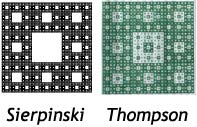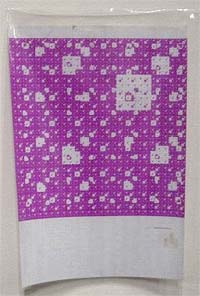Deconstructing Marty
There seems to be a bit of a backlash against Wellington "outsider artist" Martin Thompson, in reaction to Tuesday's somewhat excitable Dominion Post article about his work being "picked up" by the American Folk Art Museum. Today's edition has a featured letter from Andrew P Wood of Christchurch (the same one who reviews art for the Listener, perhaps?) saying that Thompson "exhibits no more creative expression or interpretation in filling in squares of graph paper than a computer does generating a knitting pattern. His patterns are generated by simple logic within constraints artificially imposed by the grid on the paper". Couldn't the same be said of some work by Frank Stella or Bridget Reilly?
 Stephen at Dorking Labs wrote a much more thoughtful analysis of one of Thompson's works. It goes beyond the vague pseudo-mathematical witterings of art critics whose mathematical education obviously never got beyond the contents page of Fractals for Dummies, and shows with admirable clarity how one piece is very similar to the well-known fractal figure called the "Sierpinski Carpet". As this comparison shows, Thompson's piece exhibits a little more complexity than the results of the standard Sierpinski algorithm (the lacunae in his version are filled with inverted versions of the pattern) but it's clearly a very simple fractal. Thus Stephen is right to ask "when does advanced mathematics become art, folk or not?"
Stephen at Dorking Labs wrote a much more thoughtful analysis of one of Thompson's works. It goes beyond the vague pseudo-mathematical witterings of art critics whose mathematical education obviously never got beyond the contents page of Fractals for Dummies, and shows with admirable clarity how one piece is very similar to the well-known fractal figure called the "Sierpinski Carpet". As this comparison shows, Thompson's piece exhibits a little more complexity than the results of the standard Sierpinski algorithm (the lacunae in his version are filled with inverted versions of the pattern) but it's clearly a very simple fractal. Thus Stephen is right to ask "when does advanced mathematics become art, folk or not?"There's no clear answer, but it does seem that when the mathematically-minded turn to art, they are rarely taken seriously by the art establishment. Perhaps algorithmic artist John Maeda is an exception, but probably only within a particular community of Wired-reading "cyber artists". And even M. C. Escher, despite his investigations of conceptually fashionable ideas such as representation, relativity and non-Euclidean space, is usually referred to as an "illustrator" or "draughtsman" rather than an artist.
So why is Thompson's work attracting more attention? Biography probably comes into it: art consumers love the idea of the artist as outsider, visionary or "holy fool"; an obsessive recluse shuffling through the streets rather than an art-school careerist. A Baxteresque beard doesn't hurt, and the sentimental public fascination with "savants" adds another layer of interest. We still love the idea of the hand-made individual art work with it's "aura" of authenticity, and Thompson's work always bears the traces of painstaking colouring-in, sellotaped edits and the stains of the street. Finally, there's a mystique about Thompson's origins: is he autistic or a genius (or both)? Is he (as Che suggested) an acid-ravaged hippie who "fried his frontal lobe in Alice Springs" back in the bohemian 70s?
 But I prefer another explanation: that Thompson's works are generally much more interesting than the somewhat static example shown by the DomPost. Their symmetries are less obvious, their self-similarities offset from the centre, to produce a sense of dynamism and a more elusive sense of order within complexity. The underlying mental algorithms may be only slightly more advanced than the Sierpinski-ish example, but it's enough to confound the eye and mind just enough to send you looking for irregularities and rogue shapes: they're much more the "dirty pixels" referred to by the exhibition that included his work some years ago. While still reminding viewers of crystals and Moorish decoration, there's something much more animated or even alive about these drawings, bringing to mind cellular automata (such as Conway's Game of Life) and the chunky sprites of 80s computer games. They bear the same relationship to Wood's "knitting patterns" that Disasteradio's disintegrating chiptune electro bears to shiny overproduced trance.
But I prefer another explanation: that Thompson's works are generally much more interesting than the somewhat static example shown by the DomPost. Their symmetries are less obvious, their self-similarities offset from the centre, to produce a sense of dynamism and a more elusive sense of order within complexity. The underlying mental algorithms may be only slightly more advanced than the Sierpinski-ish example, but it's enough to confound the eye and mind just enough to send you looking for irregularities and rogue shapes: they're much more the "dirty pixels" referred to by the exhibition that included his work some years ago. While still reminding viewers of crystals and Moorish decoration, there's something much more animated or even alive about these drawings, bringing to mind cellular automata (such as Conway's Game of Life) and the chunky sprites of 80s computer games. They bear the same relationship to Wood's "knitting patterns" that Disasteradio's disintegrating chiptune electro bears to shiny overproduced trance.But then, I would say that, having had the foresight to buy one when they were still going for $200!



4 Comments:
I hope you remember who your friends are when you sell it on eBay... :)
Oh, Tom, you've trumped me again. ;) Well done on your prescient purchase; was it from that show at Idiom all those years ago? I plumped for an Aranga "Sunshine" Collier piece; he has subsequently disappeared.
I agree with you; Thompson's work is normally much more interesting than the example pictured in the DomPost story. If he's not autistic, he exhibits the same kind of preternatural mathmatic ability (actually patterns and rules); I've watched him work on a piece for some time, developing it perfectly and without reference to any text or formulae - presumably they are in his head.
Andrew Wood is an idiot; the work is clearly more interesting than a computer printout. As you mention, often it's the glitches, the edits, the mistakes which give the works their engaging qualities. Basically I think the part of the art "establishment" he belongs to will always kick against the pricks of an idea that art can be something other than ironic social commentary or expressionism. And your comparison with Bridget Reilly is a very apt one.
Oh, and can we have a fight with your mate Hayden, who doesn't seem to hold to the same definition of fractal as you and I.
Oh, and the Siepinski-ish one is more interesting to me now that I've spotted the similarities; by "[filling] the lacunae in his version with inverted versions of the pattern" isn't he turning it into a super-fractal, or something?
I would've done the same thing, btw; the "holes" (lacunae) in the 2D Sierpinski carpet bug me.
I saw this show at the Museum of Folk Art when it was running, and I found Thompson's work very interesting (and lovely). The museum chose to display it in acrylic cases so you could see both sides of the work, and the effort that Thompson went to in fixing little errors in his methodical work.
Also worth noting is that the show was about obsessive eccentrics -- most of the works shown were huge, detailed, and took years to create. I don't remember if the DomPost story mentioned this. I did find their story strangely dismissive.
Post a Comment
<< Home